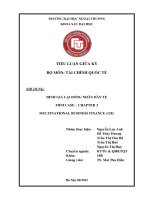Cross cultural management 3rd chapter 3 (14) business cultures in the western world
Bạn đang xem bản rút gọn của tài liệu. Xem và tải ngay bản đầy đủ của tài liệu tại đây (491.24 KB, 14 trang )
Slide 3.1
Chapter 3
Business cultures
in the Western world
Browaeys and Price, Understanding Cross-Cultural Management PowerPoints on the Web, 3rd edition, © Pearson Education Limited 2015
Slide 3.2
Concept 3.1 : European cultures
• Europe’s identity never clearly established culturally,
politically or geographically.
• a much more united Europe existed in the Middle
Ages.
• Most recent development:
– creation of the European union (EU):
• common economic, socio-cultural and political bodies.
• Council of Europe:
– aims to promote fundamental values, e.g. human
rights.
• Clear cultural differences in Europe still survive.
Browaeys and Price, Understanding Cross-Cultural Management PowerPoints on the Web, 3rd edition, © Pearson Education Limited 2015
Slide 3.3
The European Union
Figure 3.1
The European Union
Source: The European Commission ©.
Browaeys and Price, Understanding Cross-Cultural Management PowerPoints on the Web, 3rd edition, © Pearson Education Limited 2015
Slide 3.4
Western Europe
• Greece
– Not possible to talk about Europe without mentioning
Greece.
• Latin Europe
– Influence of Roman Empire
– Highly developed bureaucracies
– ‘Rule-bending’ through family and personal
relationships
– Latin European cluster characterised as being ‘low in
humane orientation practices’. (House et al. 2004)
Browaeys and Price, Understanding Cross-Cultural Management PowerPoints on the Web, 3rd edition, © Pearson Education Limited 2015
Slide 3.5
Western Europe (Continued)
• Nordic Europe
– Viking heritage:
•
self-sufficiency, fairness, egalitarianism and democracy
– Face up to authority, question it and expect to be
consulted
– Differences between the Scandinavian countries on a
socio-economic level.
• Germanic Europe
– Longer term perspective when managing uncertainty
– Assertive behaviour, explicit communication
– Emphasis on results rather than relationships.
Browaeys and Price, Understanding Cross-Cultural Management PowerPoints on the Web, 3rd edition, © Pearson Education Limited 2015
Slide 3.6
Western Europe (Continued)
• Great Britain
– United Kingdom of Great Britain:
•
England, Wales, Scotland and Northern Ireland
– Common history with Europe and relationship with EU
– Anglo-Saxon style of management:
•
Pragmatic (practical) and relaxed approach
– Organisation:
•
a market in which people negotiate what has to be done
– Individualistic:
•
individual in selection procedure.
Browaeys and Price, Understanding Cross-Cultural Management PowerPoints on the Web, 3rd edition, © Pearson Education Limited 2015
Slide 3.7
Eastern Europe
• Emergent economies
– Economies of the Eastern and Central European countries
– Russia and Turkey, have some similarities with other
countries around the world.
– ‘emerging markets’.:
– Poland, Czech Republic, Hungary and Romania:
• East and Central Europe
– Transition from bureaucratic, centralised economy to
market-oriented economies with more democratic features.
Browaeys and Price, Understanding Cross-Cultural Management PowerPoints on the Web, 3rd edition, © Pearson Education Limited 2015
Slide 3.8
Eastern Europe (Continued)
• Russia, a BRIC country
– European emergent market
– one of the BRIC countries
– largest of the former Soviet Union republic
– ‘Blat’, a Soviet form of social networking
– still flourishes to help cope with uncertainties of
new society.
Browaeys and Price, Understanding Cross-Cultural Management PowerPoints on the Web, 3rd edition, © Pearson Education Limited 2015
Slide 3.9
Eastern Europe (Continued)
• Turkey
– straddles the border between Europe and Asia
– Candidate for membership of EU, but its right to
be a member disputed:
– Turkey seen by some as not being European
culturally, socially or geographically. But what does
‘European’ mean?
– Others see Turkey as European through its influential
role in Europe over four centuries.
Browaeys and Price, Understanding Cross-Cultural Management PowerPoints on the Web, 3rd edition, © Pearson Education Limited 2015
Slide 3.10
Concept 3.2
American and Australasian cultures
• We move from the ‘European Old World’ to the
‘New World’.
• Areas where immigrants from European peoples
set up home and business.
• Concept examines:
– Anglo-Saxon approach to business
– The strong values of the Latin Europe as reflected
in Latin America.
Browaeys and Price, Understanding Cross-Cultural Management PowerPoints on the Web, 3rd edition, © Pearson Education Limited 2015
Slide 3.11
United States of America
– Originally 13 British colonies which would become the
USA
– Constitution based on the principle of equality
– Many immigrants adopted the Protestant work ethic
– Indicator of success for US businesses is the ‘bottomline’
– Difference between British and American businesses:
- the way they look at the future
• The ‘new’ immigrants
– Latin American and Asian immigrants
– Recent immigrants (Mexican) are still undergoing the
process of assimilation.
Browaeys and Price, Understanding Cross-Cultural Management PowerPoints on the Web, 3rd edition, © Pearson Education Limited 2015
Slide 3.12
Canada
• Canadians
– More a ‘mosaic’ (variety) than a ‘melting-pot’ society
– Respect for cultural diversity and cultural pluralism
– Canadian style of management contrasts to that of
the USA:
• less formalised
• less driven by individual goals
• more aware of society as a whole.
Browaeys and Price, Understanding Cross-Cultural Management PowerPoints on the Web, 3rd edition, © Pearson Education Limited 2015
Slide 3.13
Australia and New Zealand
• Australians and New Zealanders
– Increasing cultural diversity, despite Anglo-Saxon
foundations
– Business culture remains Anglo-Saxon in nature,
but more collaborative, distrust of authority.
Browaeys and Price, Understanding Cross-Cultural Management PowerPoints on the Web, 3rd edition, © Pearson Education Limited 2015
Slide 3.14
Latin America
• Despite differences between countries of
Central and South America, cultural values are
shared:
– Strong belief in Catholic religion
•
reflecting importance of families and distinct
male/female roles
• values implanted by immigrants from Iberian peninsula
– Role of ‘patron’:
•
authoritarian behaviour expected and respect shown
• Rise of middle class in Brazil is shared with
other BRICS countries.
Browaeys and Price, Understanding Cross-Cultural Management PowerPoints on the Web, 3rd edition, © Pearson Education Limited 2015









